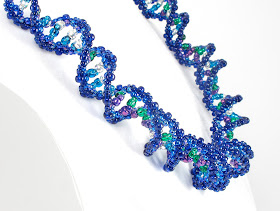Continuing with the theme of beaded DNA based off of Gwen's pattern, I figured that it was high time to use this design in a wearable item of jewelry. While I still think that my latest variation would be make a great cuff, I tend to wear more necklaces than bracelets, so I searched for the perfect sequence for a DNA necklace. Here's the final result:
The sequence of this necklace comes from the regulatory region of the lac operon of E. coli, specifically, the 106 base pairs between the start of the CRP binding site, and the start codon of lacZ. Regulation of the lac operon was the first mechanism of gene regulation to be discovered, and it remains the primary example of gene regulation taught in Genetics 101 classes today.
The lac operon contains the genes necessary for an E. coli cell to digest the lactose sugar, but E. coli prefers to munch on the simpler glucose sugar. Therefore, the genes in the lac operon are only active, or expressed, when there is no glucose around, but plenty of lactose to eat instead. The cell knows to express the lac operon through a system of proteins that monitor the presence and absence of glucose and lactose, and according to these sugar levels, certain proteins will either bind or not bind to regions of the DNA sequence depicted in this necklace. Only when the lactose levels are high, but glucose levels low, will these proteins be in the correct combination to encourage lac operon expression.
I used silver plated seed beads for the cytosines, capri blue for the guanines, green for the thymines, and purple for the adenines. For any of you who also had to memorize the ideal sequences of the -35 and -10 elements in a genetics class, the lac operon's -35 element of TTTACA is in the center of the above picture. Can you see the string of three green and purple base pairs? The -10 element sits just off-center of the necklace.
Other than its importance in gene regulation, I chose this sequence for this necklace because it's an example of noncoding DNA, or a DNA sequence that does not serve as a blueprint for a protein. These types of sequences make up over 98% of the 3 billion base pairs of the human genome, and were once called "junk DNA" because they were thought to be of little consequence. Regulatory regions such as this one are just one example of the significance of noncoding DNA.
Plus, it makes a significantly cool necklace :)





The result of your modifications to create the major and minor grooves is spectacular. I'm amazed at how regular the repeats are. Breath-taking!
ReplyDeleteThis is just awesome! And thanks for the quick update on gene regulation...a long time since I've thought about operons :P
ReplyDeleteThanks Gwen - the major and minor repeats are definitely more interesting in a longer piece of DNA.
ReplyDeleteThanks Inner Muse! Aren't operons fun? :)
I am totaly in love with this necklece ... have to try that myself ... thats a lot
ReplyDeletemmm... nerdy beading.. i like
ReplyDeleteThanks Am! Yep, I'm a total nerd, through and through ;)
ReplyDelete